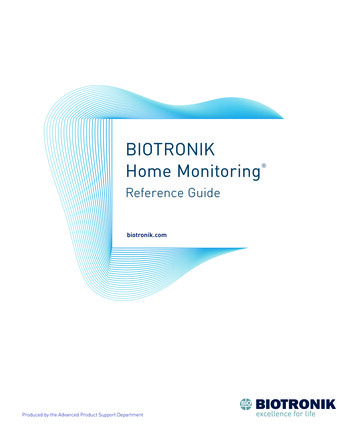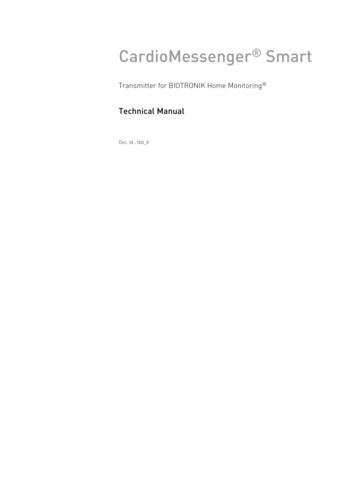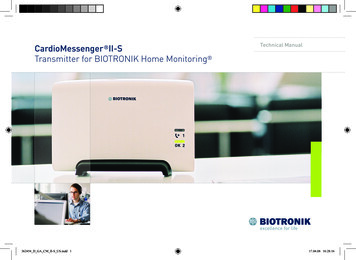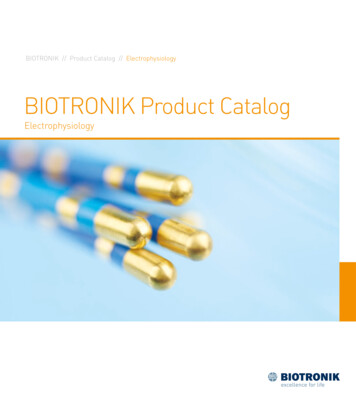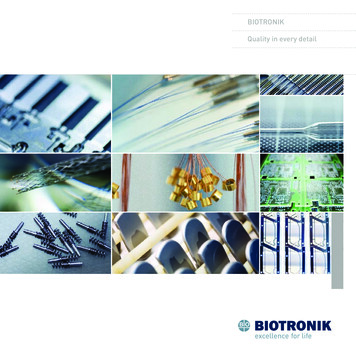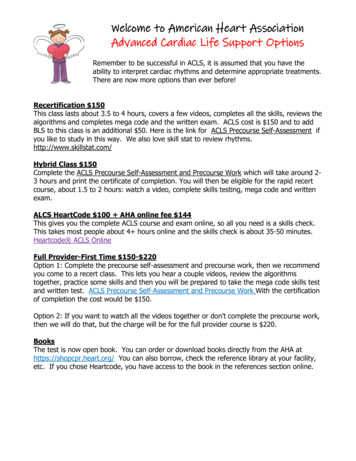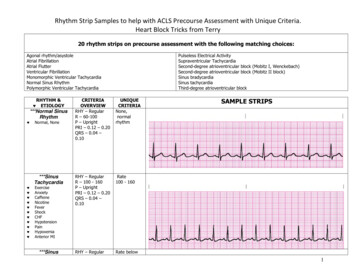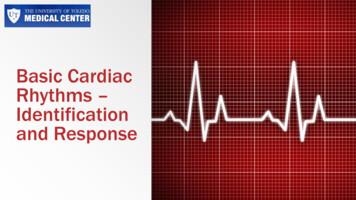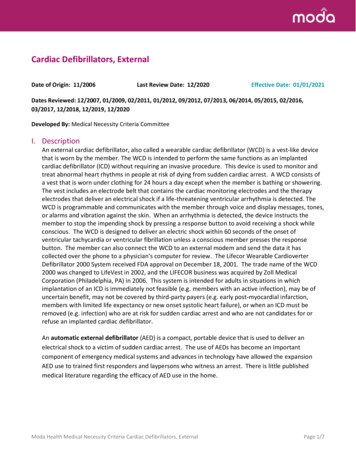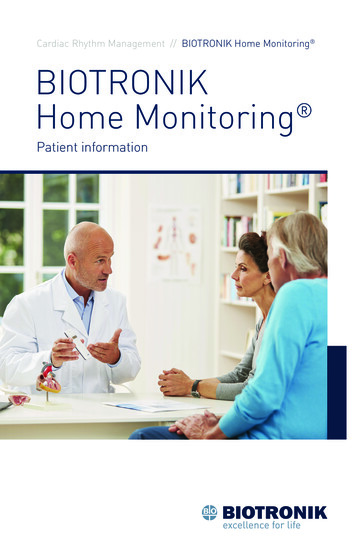
Transcription
Cardiac Rhythm Management // BIOTRONIK Home Monitoring BIOTRONIKHome Monitoring Patient information
PAGE 2
Table of ContentsIntroduction. 4About BIOTRONIK Home Monitoring . 6 Why would you needBIOTRONIK Home Monitoring ?. 7 How does BIOTRONIK Home Monitoring technology work? . 10 What information does your doctor receive withBIOTRONIK Home Monitoring and how is it used?. 11Daily life with BIOTRONIK Home Monitoring . 13 The CardioMessenger Smart. 14 The bedside CardioMessenger II-S and II-S T-Line. 18 Daily life with the CardioMessenger(at home, at work and while traveling). 19Frequently Asked Questions. 22Further Information. 29 Studies confirming the benefits ofBIOTRONIK Home Monitoring . 29PAGE 3
IntroductionPacemakers, implantable cardioverter-defibrillators (ICDs), heart failure therapysystems for cardiac resynchronization and insertable cardiac monitors have beenused for decades to improve the quality of life of cardiac patients. These smalldevices are now a common form of treatment.If you have or if you are about to have one of these devices implanted, you mightknow that you will need to visit your doctor regularly to have checkups made onyour health conditions and your cardiac device. But what if your health condition orcardiac device status changes between checkups? BIOTRONIK Home Monitoring technology will assist your doctor by monitoring it remotely from where you are.This booklet provides you with useful information about the BIOTRONIK HomeMonitoring system and answers patients’ most frequently asked questions. Inaddition to reading this brochure, be sure to speak with your doctor to make sureyou have all the information you need for your particular condition.PAGE 4
PAGE 5
AboutBIOTRONIK Home Monitoring BIOTRONIK Home Monitoring is the world’s most advanced telemonitoringsolution for patients with cardiac devices. It allows your doctor to continuouslyaccess information about your implanted system.Based on BIOTRONIK Home Monitoring information, your physician may be ableto respond much earlier to critical changes in your heart or device condition – and,therefore, perform your follow-ups in line with your medical needs.BIOTRONIK Home Monitoring regularly provides your physician with helpfulinformation about your current health care and device status – without any requiredinteraction from you.Via a secure website, your doctor is able to remotely check your device statusaround the clock, independently from what you do and where you are.PLEASE NOTE: BIOTRONIK Home Monitoring is not a substitute for appropriatemedical attention in the event of an emergency and should only be used as directedby a physician. BIOTRONIK Home Monitoring may be unavailable at times due tomaintenance or updates, or due to cellular coverage being unavailable in your area.PAGE 6
Why would you need BIOTRONIK Home Monitoring ?With BIOTRONIK Home Monitoring , every day your doctor is sent information aboutyour heart condition and how your implanted device has functioned. Most of theinformation will be good news: Your heart is beating normally, no arrhythmiasoccurred, the device is operating appropriately and the battery of your implanteddevice has plenty of energy left.Sometimes, however, between traditional in-office follow-up appointments, yourhealth condition may change silently – and your doctor would not know about it untilyour next routine checkup. With BIOTRONIK Home Monitoring , your doctor can beinformed about your status daily – allowing him or her to contact you immediatelyand, if necessary, adjust your therapy or device settings sooner than if you did notuse the system.Using BIOTRONIK Home Monitoring may improve your cardiac device’s safety1 aswell as your quality of care2 in general. The following advantages usually can be seenin clinical practice.Therapy optimizationThe physiology and condition of the heart is continuously changing. Those changesmay require your doctor to adjust your therapy from time to time, e.g., yourmedication, device programming or lifestyle. BIOTRONIK Home Monitoring allowsyour doctor to monitor your disease progression and intervene earlier thanconventional in-office follow-ups.For example, if you have a pacemaker, your physician may be keen to avoidunnecessary device stimulations in the ventricle to minimize the risk of atrialfibrillation – a main cause for strokes. If you are a defibrillator (ICD) patient, yourdevice will deliver electrical shocks if life-threatening arrhythmias occur. Shockdeliveries, however, represent a considerable burden for a patient and should beavoided unless absolutely necessary.PAGE 7
AboutBIOTRONIK Home Monitoring With BIOTRONIK Home Monitoring , your physician has the option of beinginformed after a therapy occurs – particularly a shock delivery. For instance, yourphysician can check why the therapy was delivered and whether the device behavedcorrectly. Having all this information at his or her fingertips, your physician mayadjust your therapy settings not only in accordance with your health condition, butalso in ways that minimize your risk for hospitalization.Early detectionImagine your heart beat is frequently affected by serious arrhythmias or technicalcomplications, which are not noticeable to either you or your doctor. Untreatedarrhythmias like atrial fibrillation may increase the incidence of stroke or heartfailure progression. Lead failures may result in inappropriate device therapies,which could cause anxiety and other emotional problems that can compromise apatient’s overall treatment effect. With BIOTRONIK Home Monitoring , yourphysician may receive an alert about changes in your health and see you for anevaluation sooner. The diagnosis of such events may enable your physician to reactpromptly and thereby prevent subsequent health damages.Patient follow-upsMost in-clinic routine follow-ups do not require any device change or other medicaladaptations. They do, however, involve effort from you and your physician. As longas your heart and device conditions are judged stable, your physician may decide toreplace the device interrogation from your in-clinic routine follow-ups with remotefollow-up information. With BIOTRONIK Home Monitoring , your physician canperform these remote follow-ups according to your individual needs at just theright time.PAGE 8
Is there anything wrong with me?Even knowing that your doctor will be informed when anything out of the ordinaryoccurs, you might sometimes wonder whether the device implanted in your chest isworking properly. Or, you may experience symptoms that make you feel insecure.Sometimes in these cases, patients schedule a follow-up appointment to clarify thereason for their symptoms – only to arrive at the clinic and have the symptoms seemto disappear.With BIOTRONIK Home Monitoring , your physician can easily check to see whetheryour symptoms were related to a clinical event. If you feel dizzy, feel your heart beatracing or feel a strange sensation in your heart, try to note the date and time of theepisode and contact your doctor’s office. With the help of BIOTRONIK HomeMonitoring , your physician can match your symptoms with the data stored on theHome Monitoring platform to determine what happened.PAGE 9
AboutBIOTRONIK Home Monitoring How does BIOTRONIK Home Monitoring technology work?BIOTRONIK Home Monitoring works together with a transmitter called theCardioMessenger. The CardioMessenger communicates with your cardiac implantthrough an antenna that is built inside the device. Once the CardioMessenger receives thedata from the device, it forwards them to your doctor via a secure website.Here is how the data transmission works, step by step:(1)(2)(3)(4)(5)(1) Every day your device communicates what your heart is doing. The datatransmissions usually take place at night while you are asleep. All dataare transmitted wirelessly, silently and automatically to the CardioMessenger.(2) The CardioMessenger receives the data and (3) forwards them to the BIOTRONIKHome Monitoring Service Center. All data is encrypted and transmitted via theworldwide cell phone network (GPRS) or via standard landline.(4) At the Service Center, all your data are processed automatically and summarizedinto special reports. All reports are stored for your physician on a protected website.Most of the time, the reports confirm normal activity.(5) Only your doctor and his or her team are authorized to review the data online. Yourdoctor is also alerted by email, fax or text message if something unusual is detected.If your doctor needs to see you based on the transmitted data, he or she will notifyyou to make an appointment.PAGE 10
What information does your doctor receive withBIOTRONIK Home Monitoring and how is it used?Every day, the BIOTRONIK Home Monitoring system provides useful informationabout your device and heart condition to your physician. The information includes: Any irregular heart rhythm (arrhythmia) that might occur All device activities (electrical stimulations, impulses, shocks and battery status) Certain values assessing an underlying heart failure condition Periodic and event-triggered electrocardiograms (ECGs) from the inside of your heart (IEGM) Technical information about the reliability of your leads and implanted deviceWith this information at hand, your physician can assess not only your device status,but also your heart condition.In addition to that, your doctor has the possibility to define what he or she wants to focuson: Your doctor can assign a color coding similar to a traffic light concept, where he or shedetermines in advance which events will be classified as “important” or “very important.”PAGE 11
PAGE 12
Daily life withBIOTRONIK Home Monitoring After your device implantation, you will receive your CardioMessenger.Your CardioMessenger will be in a ready-to-operate state. The CardioMessengeris the device that is required so that your data can be transmitted to your physicianwhen you are at home.All CardioMessenger devices have the same functionality, and depending onyour health condition and your lifestyle, your doctor will decide with you whichCardioMessenger would fit best for you. The CardioMessenger devices are veryeasy to set up, and each transmits your data automatically to your doctor via thecell phone network or landline. Your doctor or a nurse can explain to you howto set up the CardioMessenger at home and what the LED lights mean. During thisexplanation, you can also verify whether your CardioMessenger works properly. Toensure data transmission, remember to place the CardioMessenger no less than8 inches (20 cm) away from you and no more than 6 feet (2 meters) away from your bed.Please also refer to the user s manual for further information.PAGE 13
Daily life withBIOTRONIK Home Monitoring The CardioMessenger SmartCardioMessenger Smart is a small, lightweight, portable Home Monitoringtransmitter. It receives information from your implanted device and forwards thesemessages to your doctor. This normally occurs during the nighttime while you aresleeping. In general, you simply need to place your CardioMessenger close to whereyou sleep to ensure that the data will be transmitted properly.CardioMessenger Smart is designed for use at home or while away from home. Your doctorwill advise you if it is necessary to take the device with you while you are away from home.Here is how you should set it up:After unboxing CardioMessenger Smart, locate the power adapter cable. Plug thepower adapter into an ordinary wall outlet (120/220V).1.Connect the small plug (micro USB plug) into the right side of the CardioMessenger Smart.Make sure that the marking (white arrow) is on the upper side of the plug.The connector port is labeled with thefollowing symbol:2.Insert the power plug into the wall outlet.Make sure that the outlet is easily accessible and not connected to a light switch inorder to prevent the CardioMessenger Smart from accidentally being turned off.The CardioMessenger Smart will now power on automatically and perform a self-test. It isPAGE 14
ready for use once the self-test is completed and the following icons are displayed indicatingthat the device has successfully completed the self-test and the battery is charging:At night, the CardioMessenger Smart should be placed close to your bed to ensurethe nightly data transfer from the implanted device. The bedside table or headboardare ideal locations for your CardioMessenger Smart, as they typically meet thefollowing conditions:The CardioMessenger Smart is placed on a solid base and cannot fall.The distance to the implanted device is less than 2 m (6 feet), so that theCardioMessenger Smart is within communication range of your implanted device.You should leave the device connected to the power adapter at all times unlessinstructed by your doctor to take the device with you when away from home. Be sureto take the power adapter with you to recharge the CardioMessenger Smart if youplan to be away from home for more than 48 hours.Check once a day (typically before going to sleep) if the CardioMessenger Smart isswitched on and ready for use. This is indicated by the following icons:Turning Off the CardioMessenger SmartSince the CardioMessenger Smart contains a mobile (“cellular”) module, you mayneed to switch off the CardioMessenger Smart for safety reasons in areas where theuse of mobile phones is prohibited (e.g., airplanes).PAGE 15
Daily life withBIOTRONIK Home Monitoring Press and hold the bluekey on the right side of the CardioMessenger Smart fortwo seconds until the display turns off.The CardioMessenger Smart has the following icons:Operation icon. The CardioMessenger Smart is ready for use.Call back icon. If this icon flashes, contact your physician during normaloffice hours. Refer to Section 4 of the CardioMessenger Smart ProductManual for more information.Information icon. If this icon flashes, a cellular connection cannot beestablished. Please try relocating the device in the room. Refer to Section5 of the CardioMessenger Smart Product Manual for more information.The battery icon is always displayed with 1-3 bars according to thecharging status. Refer to Section 6 of the CardioMessenger Smart ProductManual for more information.The CardioMessenger Smart is connected to the power supply and charging.PAGE 16
During charging, the individual segments of the battery icon flash alternatingly and asmall power plug is displayed. The three bars on the battery icon flash successivelyuntil the CardioMessenger Smart is fully charged. Once it is fully charged, all threebars are completely filled. The charging process usually takes three hours.Your CardioMessenger Smart needs to be charged immediately when the batterymonitor light contains no bars and is flashing.Please consult the Product Manual included with your CardioMessenger Smartfor additional instructions on the use of this product.PAGE 17
Daily life withBIOTRONIK Home Monitoring The bedside CardioMessenger II-S and II-S T-lineThe CardioMessenger II-S and II-S T-line are home-based transmitters used tofacilitate the once daily transmission of cardiac and technical implant data to yourphysician. Both models perform the same data transmission function; however, theydo it in slightly different ways. The CardioMessenger II-S uses a mobile network(cellular GSM network) to transmit data to your physician, as opposed to the T-linemodel, which uses a standard household telephone line for data transmission.Since your implanted device usually communicates with the CardioMessenger II-S atnight while you are sleeping, choose a location near your bed to keep yourCardioMessenger II-S – usually on your nightstand or headboard. You will also needto connect the CardioMessenger II-S to a power outlet.As soon as you connect your CardioMessenger II-S to the power supply, data will betransmitted automatically to your physician starting the following night.PAGE 18
Here is how you should set it up: (T-line only) Connect your Cardiomessenger II-S to your telephone line connection,following the instructions included with the device. Plug the bigger plug of the power supply cable to an ordinary wall outlet (120/220V) andthe smaller plug of the same cable into the left side of the CardioMessenger II-S. The CardioMessenger II-S will automatically turn on and conduct a self-test.The “OK 2” light will illuminate yellow for about fifteen minutes. As soon as the self-test has been performed successfully, the “OK 2” light will turngreen and data should be transmitted without any problem.I f the “OK 2” light remains yellow, the CardioMessenger II-S is not able to establisha connection to the service center. After 48 hours, if a connection can not beestablished, please contact BIOTRONIK Technical Services.Usually, only the lower operating “OK 2” light is green and the upper call-backlight () is not illuminated. If the call-back light blinks yellow, your doctor turnedit on to ask you to call him or her. Please call your doctor as soon as you realize thatthe call-back light is blinking. The call-back light will blink yellow for a maximum ofthree days. If you want to turn it off earlier, just disconnect power from yourCardioMessenger II-S for a few seconds and then reinsert it.The bedside CardioMessenger II-S does not have an on/off button. Simply leave yourdevice plugged into the electrical wall outlet at all times.Daily life with the CardioMessenger(at home, at work and while traveling)The CardioMessenger devices were designed to easily integrate into your normal,everyday routine. They work almost anywhere there is reliable cellular data access ora household telephone line.PAGE 19
Daily life withBIOTRONIK Home Monitoring In general, you simply need to place your CardioMessenger, regardless of whether it is theportable or the bedside transmitter, close to your bed to ensure that the data will betransmitted properly. You can take the CardioMessenger Smart with you when you spend anight away from home - such as when you go on vacation or need to stay overnight in thehospital.You can carry the CardioMessenger Smart with you at any time, although it should not becarried directly over the implant (for example, in your jacket pocket). Your doctor will adviseyou if you need to carry your CardioMessenger with you when you travel away from home.If you plan to travel for an extended period of time or travel out of the country,discuss your plans in advance with your doctor. He or she will ensure that yourCardioMessenger will work properly during this time period. For example, if you aretraveling outside of your time zone, your doctor may want to reset the time whenHome Monitoring sends its daily report.Keep in mind that BIOTRONIK Home Monitoring works in more than 160 countries.To check where BIOTRONIK Home Monitoring works, please visitwww.biotronik.com or ask your doctor.Please note that your CardioMessenger Smart will not be damaged by airportsecurity X-ray or anti-theft devices in shops or libraries. And, like you would do withyour mobile phone, don’t forget to turn it off on an airplane.PAGE 20
PAGE 21
Frequently Asked QuestionsWhy do some people have BIOTRONIK Home Monitoring and others don’t?BIOTRONIK Home Monitoring is only available with certain pacemakers, defibrillatorsand cardiac resynchronization therapy devices from BIOTRONIK. Your physician will helpyou decide whether BIOTRONIK Home Monitoring is right for you.Ca
BIOTRONIK Home Monitoring BIOTRONIK Home Monitoring is the world’s most advanced telemonitoring solution for patients with cardiac devices. It allows your doctor to continuously access information about your implanted system. Based on BIOTRONIK Home Mon

